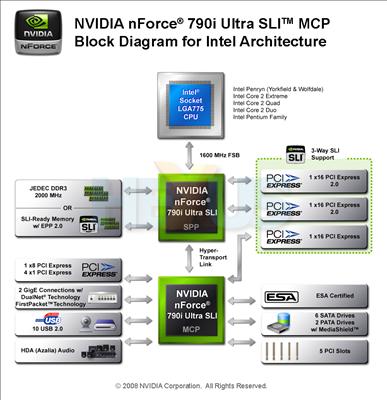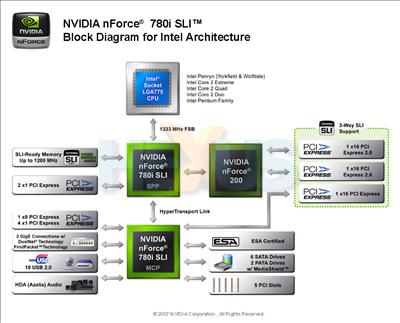The innards
Background
As a recap for those that don't read the introduction, back in November 2006, NVIDIA scored a few home runs. It launched the GeForce 8800 GTX - a GPU that heralded all subsequent designs, right up to the GeForce 9800 GX2, also released today.Then it launched what was to become the enthusiast chipset of choice for Intel LGA775 CPUs. Yes, the nForce 680i SLI was expensive, retailing at around £200 at the time of launch, but it provided hither-to unseen levels of tweaking and performance, and provided SLI - NVIDIA's multi-GPU technology - too.
Intel - the quintessential purveyor of high-quality chipsets - offered competition with its i975X and, recently, X38 chipsets, supporting ATI's CrossFire multi-GPU technology, but, invariably, the enthusiast veered towards NVIDIA's platform. Certain commentators reckoned its stability wasn't as bullet-proof as Intel's, yet the 680i gained popular acclaim.
Intel then released a handful of high-end, 45nm Penryn-based processors in Q4 2007. The company's own chipsets supported the new, faster CPUs, but NVIDIA's nForce 680i SLI had board-level integration problems with the Penryns, which have now been released in top-to-bottom dual- and quad-core forms.
NVIDIA launched an interim Intel-based chipset, nForce 780i SLI, to circumvent the problems. At the same time, it also added in PCIe 2.0 support via a bridging chip, nF200. 780i SLI, though, was merely a stop-gap until the launch of its fully-fledged successor, the nForce 790i Ultra SLI.
Meet the new 790-series family, from NVIDIA
Designed to compete against Intel's X48, officially launched a couple of weeks' ago but available for a couple of months, nForce 790i (Ultra) SLI purports to be the all-singing, all-dancing chipset for 45nm dual- and quad-core processors that 680i was for the Conroe generation, so let's take a closer look with the help of a block diagram.Take a closer look at the block diagrams for the nForce 790i Ultra and 780i (underneath) and it's mostly the same - why change a winning formula?
The differences, though, are enough to warrant a new nomenclature.
Firstly, there are two variants of the nForce 790 chipset - regular and Ultra. The non-Ultra is basically the same, save for slower memory support - 1,333MHz for the non-Ultra vs. 2,000MHz for the Ultra. Both support NVIDIA's EPP 2.0 for plug 'n' play settings of high-speed memory, through a one-click BIOS setting.
nForce 790i Ultra SLI vs. 780i SLI
Starting at the top, 60-PCIe-lane nForce 790i Ultra SLI officially supports all 45nm Intel LGA775 CPUs, including the Extreme Edition QX9770, operating off a 1,600MHz front-side bus.Keeping the performance theme going, 790i adds in DDR3 support right up to 2,000MHz. Ultra-high-speed DDR3 is still too expensive to recommend to anyone but the hard-core enthusiast, but the price of, say, 1,333MHz packs is steadily dropping to a point where a 2GiB kit can be purchased for <£100.
The new northbridge doesn't require the nF200 bridging chip for PCIe support. Rather, it can natively run 32 lanes of PCIe 2.0, usually split into 2x x16s for graphics. A further 16 PCIe lanes, albeit it 1.x, are pulled from the southbridge, enabling three-way SLI, which is limited to the GeForce 8800 GTX and Ultra cards. In short, the 790i northbridge takes the place of the nF200.
A HyperTransport 1.0 link connects both chipset bridges - SPP and MCP - via a 1GHz (1GB/s) interconnect.
Take a closer look at the two block diagrams for the nForce 790i Ultra SLI and 780i SLI and you'll see there is no meaningful difference between the two MCPs. In fact, both are rebadged nForce 570, as found on the nForce 680i chipset. NVIDIA reckons that it has stood the test of time and we tend to agree. 10 USB2.0 ports are plentiful; expansion opportunities are good; gigabit networking can be teamed up; and the storage subsystem - six SATA2 ports, (including one eSATA), and two-channel PATA - matches what Intel and AMD has to offer.
The 7-series chipsets also feature what NVIDIA terms as PWShort (Post-Write short), useful in an SLI environment, where GPUs can communicate updates to one another without having to navigate through the busy memory-to-PCIe controller.
Thinking more about SLI, also common to the 7-series is the Broadcast function, where CPU-originated data - including textures, geometry, and basic rendering - is fed to the GPUs in a concurrent fashion, rather than meted out on a one-by-one serial basis.
nForce 790i Ultra SLI is best thought of as an incremental update to both the incumbent 680i SLI and 780i SLI boards. There is no compelling reason to look at either erstwhile chipset, save for price and if you have a stack of quality DDR2 that's going begging.
NVIDIA's will line up the usual partners to roll out reference nForce 790i (Ultra) SLI boards, including eVGA, XFX, and Gigabyte. A few others, including ASUS and Foxconn, will engineer their own designs, released a month or so later.
Technical summary
Generally matching the feature-set on offer from the recently-released Intel X48 chipset and priced at around the same levels, the NVIDIA nForce 790i Ultra SLI will be best-suited to well-heeled enthusiasts looking at a high-quality base for the ultimate PC.The revised northbridge does away with the bridging chip, and DDR3-2,000 support, straight off the bat, guarantees high system bandwidth.
The nForce 790i Ultra SLI is sheer overkill if running a system at stock speeds; it only comes into its own once the CPU's FSB is pumped up to 2,000MHz (QDR) and memory is run at appropriately outrageous levels.
An obvious downside is price, and we estimate partner boards to retail around £200, pushing it out of reach for most enthusiasts. NVIDIA, though, has already released a lower-cost 7-series chipset, nForce 750i SLI, that cuts down on features but is designed to appeal to the masses.
We managed to grab an eVGA nForce 790i Ultra SLI board at the last minute and are currently testing its overclocking prowess, which will be published in a later article. For now, keep reading to see just how it's laid out and what you receive in the large box.











